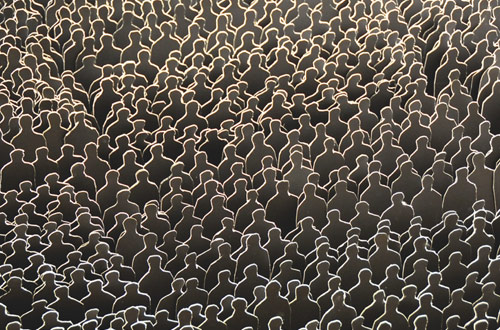All about Africa - Khaleej Times
Posted under Views on February 25th 2011

Tens of pastel paintings illustrating people — melancholic but peaceful — have gotten to their company bicycle tyres. Smiling happy as a child showing these naive figures, Cheikhou Ba explains how he began to cycle in Ii. The neighbourhood was wondering who this lonely man with the bike cycling zig-zag on the streets was.
Inspired by the townspeople Cheikhou Ba created little plastic men riding a wire bike. The story behind the sculptures reaches all the way to the plastic bags of the local grocery.
Further down installations exploring environmental issues such as global warming and recycling are on display. In his work, Aya Aina
uses unusual and everyday objects such as rat traps, toilet bowls, nails, bullet holes, fresh vegetables, cooked rice, fire, water and hospital beds to create a provocative but humorous
social commentary.
The highly emotive and powerful ceramic busts that Kevin Dalton-Johnson creates are cathartic and provide a spiritual connection with his African ancestors. They are intense and many who see them are stunned when they appear to speak.
'Statements of Intent, A Generation Provoked' is the third exhibition in a four part multi-faceted series on till February 27 at The Mojo Gallery titled 'As It Is! Contemporary Art from Africa and the Diaspora.'
The exhibition focuses on a younger generation of international contemporary African artists working within Africa and the Diaspora. They are at the cusp of their creative careers, carving out a place for their artistic ideologies.
Issues of identity are crucial to understanding today's society and more specifically to Johnson's work as a British/Jamaican visual artist born in the United Kingdom. Like many others he experiences a great sense of displacement from living with the effects of limited and fragmented information about their culture and heritage.
"Understanding the dislocation experienced by many Diasporic artists has been central to my work as a professional visual artist. My specialism is ceramics, where I feel at home, making large expressive sculpted busts that act as a visual diary of events that reflect my identity and journey as an African Diasporic man living in the United Kingdom," he says.
The artists raise the subject of displacement — as Africans living and working in the Diaspora — willingly or unwillingly due to several factors including political and social turmoil in their respective countries. Furthermore, the interrogatory nature of their work highlights the ethics of the colonial past and questions existing structures of dominance and control in the form of modern capitalism.
Aina's art employs metaphor, humour and irony to address critical issues of social and political injustices, and environmental degradation. Industrialisation, with its attendant problem of waste generation offers him a rich menu of junk to satisfy his creative appetite. "As an artist in a recycling age, I see myself positioned as a recycling machine powered by mixed media and multimedia," he says, adding, "The slave trade was legally abolished over 200 years ago but our modern world embraces more subtle and deceptive methods of enslavement… contemporary slavery. The only thing that has changed is perhaps nomenclature. The media is filled with stories of human trafficking and forced child labour. A good percentage of the populace live a degraded contemptuous life, toiling long, strenuous hours on jobs that hardly provide for their basic survival needs and give no room for fair working conditions. These are some of the issues addressed in these works," says the artist.
The artworks observe and represent all realms of life including the dysfunctional nature of the world we live in.
Issues of rejection or marginalisation, both personal and societal, are raised as well as commentary on society and humanity and how it may or may not have inspired the artists' philosophical thought. "Work for me is a daily need. The space and time can be very instrumental in my creation," says Ba, adding, "Beyond the spiritual journey, which undoubtedly more than anything else feeds the creative capacity, the physics that leads us to a region or country to another, enhances the creative universe. During travel, breaking barriers and borders, cultures and experiences collide. Facing the other, one wonders who we are, hence what we come from. In our differences we must learn to take advantage."
The curator of this exhibition Annabelle Nwankwo-Mu'azu says that perceptions about the African art should be put aside and the realities of the creative nuance should be recognised and celebrated. "Our desire is for the viewer to walk into the space, and suspend judgment, disengage from what is assumed or expected and embark on an experience that is not confined or structured. To not just see the work, but feel and hear the messages revealed."
Thus encouraging dialogue and debate
through their art, the viewer contemplates, dissects, questions and perhaps relates to the meanings implied.
Read Article in full on Khaleej Times








Comments
Leave your comment